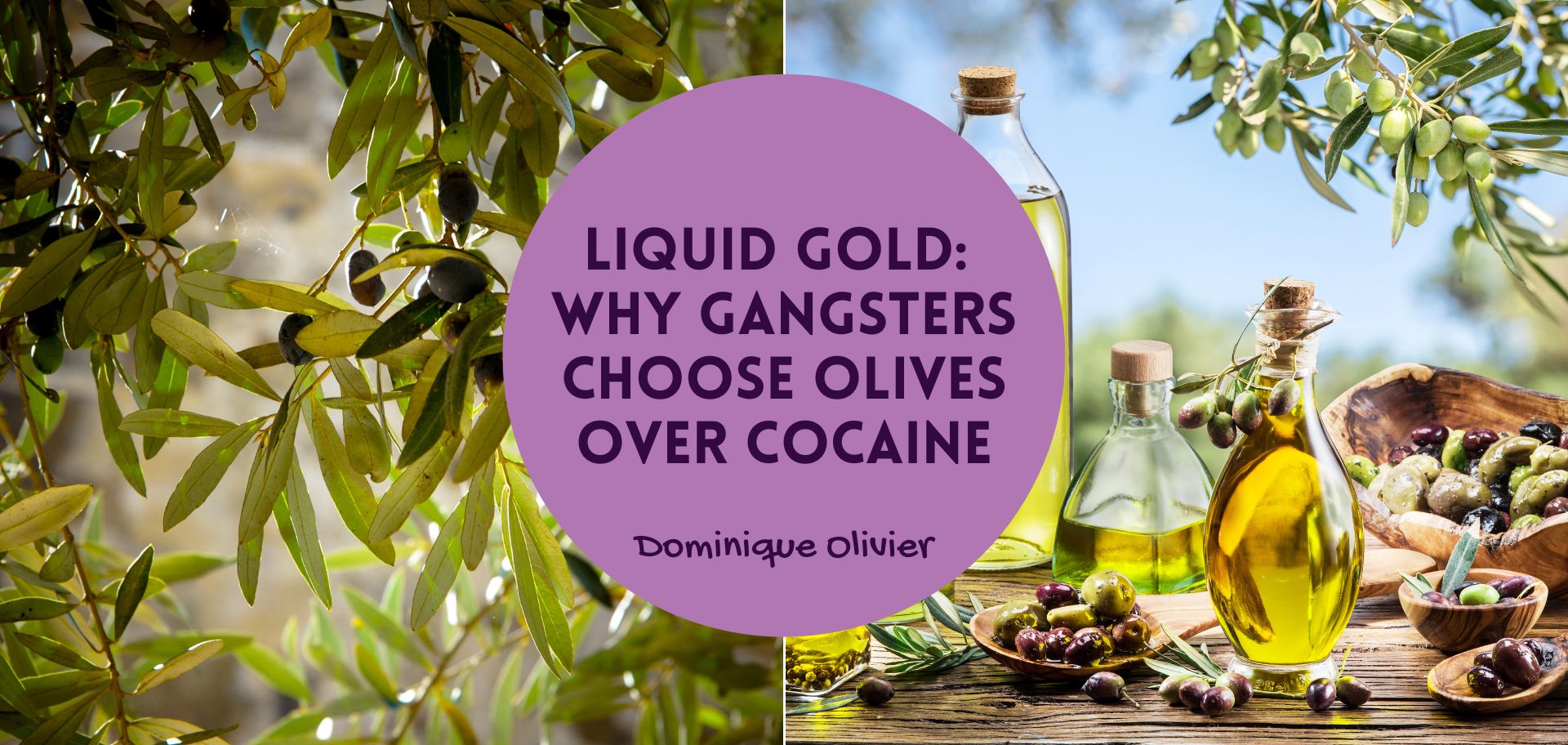Miniature cameras hidden in tie pins. Bribery money counted under tables. Swiss bank accounts, Turkish tankers and Caribbean shell companies. No, we’re not talking about the cocaine trade. We’re talking about the Italian agromafia.
If you walk into your kitchen right now, odds are you would find some version of olive oil, either in your pantry or right next to your stove. I would guess that the vast majority of us start our cooking with a splash of a pure olive oil, or at the very least an olive and seed-oil blend.
The most coveted in the olive oil family – the extra-virgin variety – will set you back between R88.99 and R169.99 for 500ml at your local Woolworths. Yet despite having a substantially higher cost than other cooking oils like vegetable, sunflower and canola, extra-virgin olive oil reigns supreme in our hearts and in our shopping baskets.
Here’s the thing though: about 80% of all of the extra-virgin olive oil on the market is either fake or adulterated. Turns out there’s real money to be made in olive oil-related fraud, which industry insiders have described as being “as lucrative as the cocaine trade, but with less violence”.
We know this because in 2016, a special Italian police taskforce dubbed “Mamma Mia” (I promise I’m not making this up) uncovered that thousands of tons of low-quality oils from Spain and Greece – some of which didn’t even originate from olives – were being bottled, labelled and sold as extra-virgin Italian olive oil.
Extra-virgin, extra problems
As consumers, we are generally savvy enough to know when a price is too good to be true. That’s why we might look at the R90 bottle of oil at the local retailer that claims to be extra-virgin and know that the label is probably fibbing a bit – but we’re OK with it, because we like the price.
The real anger starts when you pay upwards of R500 for an extra-special, extra-virgin bottle of oil that claims to be from a quaint Italian monastery on a verdant hill, only to learn that you’re paying for something that came from neither Italy nor an olive.
The surge in the counterfeit olive oil trade – dubbed the agromafia – can be attributed to several factors. Firstly, for the past 10 years, there has been a 35% increase in olive oil consumption in southern Europe, its traditional market, and a remarkable 100% rise in North America. This growth is primarily driven by the popularity of the Mediterranean diet, which relies heavily on extra-virgin olive oil and the promoted health advantages associated with its consumption.
So on the one hand, we have a keen market. On the other, we have the fact that the extra-virgin variety of olive oil is time-consuming and difficult to make.
In adherence with European Union regulations, extra-virgin olive oil must be produced solely through physical methods, such as pressing or centrifugation, and must satisfy thirty-two chemical criteria.
The prestige of making it through these rigorous processes justifies the price that customers are willing to dock up for the real deal – but it also invites the devious intentions of those seeking a shortcut to profit.
Remember that SHEIN article from a few weeks ago, where I wrote about the problems that occur when a consumer base adjusts to paying a cheaper price for knockoff products? You’re seeing it play out in real time here. In Puglia, which is responsible for around 40% of Italy’s olive production, farmers have grappled with this crisis for over a decade.
Instead of prioritising support for small producers creating unique, high-quality oils, the Italian government has consistently favoured quantity over quality, which has benefitted large corporations specialising in bulk oil sales. Small-scale farmers are getting squashed as a result.
As always, demand continues to shape supply.
A problem as old as olives
One of my favourite tidbits that I picked up while researching this topic is just how old the olive oil industry is – and how long the adulteration of olive oil has been a problem.
Let me give you some context to what I mean by “how long”. Somewhere between the 1st-3rd centuries AD, Emperors Trajan and Hadrian ruled over the Baetica region in southern Spain, now known as Andalusia. The amount of olive oil sent from Baetica to Rome during that time was so vast that the discarded clay amphorae, used for transportation of the oil and left in a dump at the southeastern edge of the city, formed a hill standing fifty metres high.
Upon closer inspection of the shards, it became clear that these amphorae exhibited thorough anti-fraud measures. Each container was meticulously marked with the precise weight of the oil, the origin farm where the olives were pressed, the merchant responsible for shipping, and even the name of the official who verified the information before dispatch.
Upon delivery, reverse checks were conducted when the amphorae were emptied to ensure that the weight and quality had remained consistent throughout transportation. This stringent labelling system – which, may I remind you, was hand-carved into the side of a clay amphora – supposedly aimed to counteract the risk of merchants substituting an inferior product during transit.
So, clearly not a new idea at all. Although dare I say, it sounds a bit like the ancient Romans had more stringent anti-fraud measures in place than the olive oil producers of today.
These days, you might want your salad sans-oil
Sadly, things aren’t looking up for the industry at the moment.
Bad weather over the Mediterranean, including a massive drought in Spain (which is currently the world’s largest olive producer), has negatively affected the most recent olive harvest. According to a statement by The European Commission, olive oil production in Spain, Italy and other European Union countries would recover only slightly from last season’s 40% decline, limiting supplies and pushing up prices.
In Greece, the demand for olives is so high that gangs of chainsaw-wielding bandits are breaking into unguarded groves and literally stealing whole branches off of olive trees.
As you can imagine, the shortage of genuine olive oil does not bode well for the purity of the extra-virgin splash that you’ll be adding to your next salad. With supply at a low, demand sky high, and customers demonstrating that they are willing to pay inflated prices as a result, the incentive for oil-substituting crooks to create their own blends is higher than ever.
About the author:

Dominique Olivier is a fine arts graduate who recently learnt what HEPS means. Although she’s really enjoying learning about the markets, she still doesn’t regret studying art instead.
She brings her love of storytelling and trivia to Ghost Mail, with The Finance Ghost adding a sprinkling of investment knowledge to her work.
Dominique is a freelance writer at Wordy Girl Writes and can be reached on LinkedIn here.





Fascinating article, thank you! It would be interesting to know if the counterfeiting is happening locally as well. We have a couple of prestigious oil-producers in South Africa which reduces the need to even consider a Spanish or Italian product.
Hi Justine!
So I did a bit of digging, and while there isn’t much info out there, I did find one article from 2001 that spoke of a team effort between Carte Blanche, SAPS and SAOGA (SA Olive Growers Association) to bust a number of fraudulent olive oils that were popping up on local shelves. Most of the oils they tested were the made-in-Italy kind, but they did also test a handful of local oils (no info given on which brands sadly) and the local oils all passed the test. 6 the foreign oils tested during that bust were found to be coloured sunflower oil!
I think the olive oil industry in SA is relatively young (especially compared to Mediterranean peers), which means that counterfeiting probably isn’t as rife just yet. We also have a local watchdog in the form of SAGOA keeping an eye on things. For extra assurance, local olive oil brands can voluntarily apply to have their oils tested by SAGOA and receive a CTC seal on their bottles. My guess would be that if you were looking for a local oil brand with nothing to hide, then that CTC seal should be on your radar.
Thank you for a very interesting article, beautifully written.. It has alerted me to steer clear of those special offers and rather buy local olive oil from our own farms.
Thank you Errol, I’m glad you liked it! And yes – our local oils are very good, so now we have even more reasons to skip the imports and support our local farmers.
What about the olive trees actively being destroyed in Palestine
Hi there Ebrahim,
thanks for your comment. It would appear that the story about the Palestinian olive trees got lost under the Mediterranean weather crisis and the Greek olive theft in the news cycle. It didn’t come up when I initially researched this topic but I’m glad you’ve raised it, especially against the backdrop of the humanitarian crisis linked to the destruction of these trees and the livelihoods of those who depend on them.
I’ve done some reading now and it seems unlikely that this will have an effect on the broader olive oil fraud story (the focus of this piece), as most of the olive oil produced in Palestine appears to be consumed locally.
In the meantime, something sinister is afoot elsewhere.
Israel, since 1967, has illegally uprooted and destroyed an estimated 800 000 Palestinian olive trees. Read “Israel’s Campaign Against Olive Trees” in the Yale Review of International Studies. Link below.
https://www.google.com/url?sa=t&source=web&rct=j&opi=89978449&url=http://yris.yira.org/global-issue/6018&ved=2ahUKEwjYoq6hhNKCAxV9XUEAHdfADKQQFnoECBYQAQ&usg=AOvVaw0S5K3l4y8eZhKLrzzhvIII
I have previously been warned of exactly this and now only buy locally produced extra virgin olive oils with the correct stamp/ sticker verifying it’s authenticity, of course it cost more
Yup, and as we learned here, this has been a problem since the age of the emperors! Good on you for choosing to buy local David. That’s a win for you and a win for our local producers.
I have been using andante extra virgin olive oil, I recently changed to Ayama cold extracted extra virgin olive oil for the 5lt container as it is less costly when I came to this country many years ago I used Costa olive but it was not as refined as we used in Italy then
The local oil are good can you comment ida Vignazia
Hi there Ida,
While I don’t pretend to have the last word in which local olive oils are good, I can tell you from my research that it pays to look for the CTC Seal on a bottle of olive oil before buying. The CTC Seal means that the olive oil has been tested by the SA Olive Growers Association and is certified genuine.
For advice on which brands to buy, you can also have a look at the last year’s winners in the SA Olive Awards. Have a look at the link here: https://www.foodandhome.co.za/lifestyle/news-and-trends/winners-extra-virgin-olive-oil-2023-olive-awards
Greetings,
Rule of thumb, “local is lekker”- buy only Italian cars not their oil because the Mob will never fake them; walk away from Greek, Spanish or imported oils as a matter of fact – that’s it.
Speaking as a fan of Italian cars and local olive oils, I couldn’t agree with you more, Mzi!
Brilliant article. Thankyou
Thanks for reading Leon!